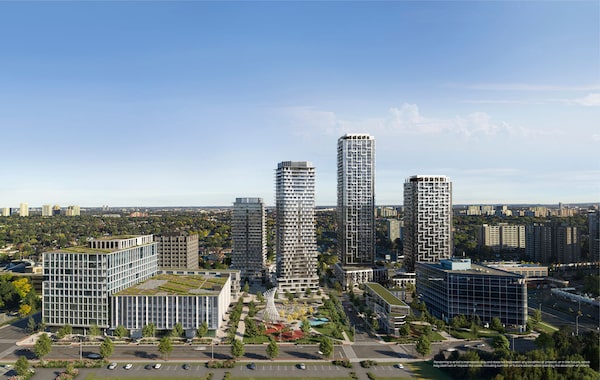
An artist’s rendering of the 15-acre LSQ mixed-use community at the northeast corner of Sheppard and Victoria Park avenues in Toronto.Almadev
Lansing Square is a quintessential example of what was called an office park in the 1980s. A pair of mid-rise office towers and a couple of two-storey commercial buildings are surrounded by acres of asphalt parking lots. Those who work there drive to it and then drive home again.
The 15-acre site at the northeast corner of Sheppard and Victoria Park avenues in Toronto is about to be transformed into LSQ, a master-planned mixed-use community that will have even more office and retail space, along with residential towers and an actual park.
“Taking a parking lot and turning it into a community was the only way to go, because the days of having empty or underutilized spaces in the Greater Toronto Area are over,” says Rafael Lazer, chief executive officer of LSQ’s developer Almadev.
“We are facing a housing crisis in Toronto, and we need to think outside the box and reimagine underutilized parcels of land without taking away what was there,” he says.
The two low-rise commercial buildings on the site have already been demolished, to be replaced by an 11-storey office tower built atop a new parking structure, which frees up all the surface parking area for redevelopment. In addition to over 40,000 square feet of office, there will be 50,000 square feet of retail and nearly 1,600 new residential units – including 160 affordable rental units – in six buildings up to 43 storeys tall, along with a 1.2-acre central park.
The redevelopment coincides with an international discussion about creating what are known as 15-minute communities, says Scott Pickles, Avison Young’s principal and senior vice-president for consulting services in Canada. The theory posits that people become far less car dependent if home, work, shopping and amenities are within 15-minute walking, biking or transit distance; it has been adapted in a variety of forms in several European cities.
Shopping malls across Canada and around the world are recognizing that their greatest potential is in the lands that they own and to be able to add residential creates a better land use and better consumer experience.
— Scott Pickles, principal and senior vice-president, consulting services Canada, Avison Young
The theory has also inspired extended versions of the plan. In Sydney, Australia, the goal is a 30-minute city, while Singapore’s master plan aims to make it a 45-minute city surrounded by 20-minute towns.
“Planning suburbs decades ago often resulted in having residential areas separated from commercial. That thinking has evolved [toward creating] live-work neighbourhoods which benefit from more micro-mobility options such as transit, electric scooters and bikes that have expanded the distance you can travel without a car,” Mr. Pickles says.
The pandemic also gave incentive to not having to commute long distances to work, he adds. Hybrid office arrangements that create suburban hubs employees can work in rather than in their homes or a central office are also gaining traction.
“The world is changing and where we can work has changed. Where suburbs give you the choice, you have options of when and how far you need to travel to work,” he says.
The incentives are economic as well as practical, Mr. Pickles says. “Shopping malls across Canada and around the world are recognizing that their greatest potential is in the lands that they own and to be able to add residential creates a better land use and better consumer experience.”
The zone around Sheppard Avenue East in Toronto is already one of the highest concentrations of employment opportunities outside of Toronto’s downtown core. Offices in the area currently employ 20,000, and an additional 13,500 office jobs are anticipated in coming years, according to a City of Toronto growth plan titled ConsumersNext that encourages mixed-use densification in North York.
The multidisciplinary study, led by R.E. Millward + Associates, developed a planning and design framework for what is known as the Consumers Road Business Park, including the Sheppard and Victoria Park intersection, calling for adding residential density to what are currently mostly commercial sites.
The area is near major transit routes, including the subway’s Don Mills station, bus routes, Highway 401, Highway 404 and the Don Valley Parkway. In addition, LSQ is along the route of a proposed Sheppard East light rail transit route.
It’s not the only mixed-use planned redevelopment Almadev is building. “We are thinking about walkable communities in all of our projects,” Mr. Lazer says. “Our developments are master-planned communities and all of them provide pedestrian-friendly live-work space surrounded by retail and well connected to transportation.”
Office and residential space at Galleria on the Park at Dupont and Dufferin streets is replacing the 1970s-era shopping mall.Almadev
Almadev’s Galleria on the Park at the intersection of Dufferin and Dupont streets in Toronto is replacing a 1970s-era shopping mall with 2,900 new residences, 150 affordable housing units, 300,000 square feet of retail and 20,000 square feet of office space. The 20-acre site includes a new eight-acre Wallace Emerson Park and a 90,000-square-foot community centre. Its proximity to public transit and ample parking space made it prime for redevelopment, Mr. Lazer notes.
The company also developed the Cité Nature condominiums adjacent to Montreal’s Olympic Village and redeveloped the Nordelec building, a former Northern Electric Company factory in Montreal, into condos.
But North York is a strong focus of opportunity for Almadev, which has just completed another suburban master-planned community on Sheppard Avenue, not far west of LSQ, called Emerald City. Its 35-acre site across from Fairview Mall now includes 3,000 condominium units and hundreds of rental units in 16 buildings.
“This is an area we strongly believe in,” says Mr. Lazer. “It’s fortuitous timing that just as we close one chapter, we are breaking ground on another.”

Located across from Fairview Mall on Sheppard Avenue West, Emerald City has 16 buildings of condo and rental units.Almadev